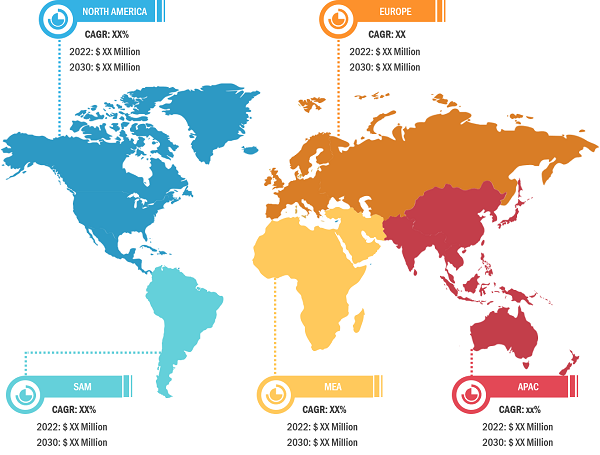Increasing Demand for AI-based Power Electronics Create Opportunities in Market During 2022–2030
According to our latest market study on " Power Electronics Market Size and Forecast (2020–2030), Global and Regional Share, Trend, and Growth Opportunity Analysis – by Type, Material, and Industry Vertical," the market was valued at US$ 43.37 million in 2022 and is expected to reach US$ 65.36 billion by 2030; it is estimated to record a CAGR of 5.3% from 2022 to 2030.
Technological giants worldwide are highly focused on research and development of new technologies. Artificial intelligence (AI) is positioned as one of the major next-gen software technologies in the power electronics market. Artificial intelligence (AI) is transforming the way power electronics operate, especially in controlling the power quality cycle. Incorporating AI into power electronics helps businesses to streamline operations and automate tasks. For instance, in November 2020, Eneryield AB created an AI-based predictive method to control a wide range of power electronics.
Power Electronics Market — by Geography, 2022
Power Electronics Market Size and Forecast (2020 - 2030), Global and Regional Share, Trend, and Growth Opportunity Analysis Report Coverage: By Type (Power Discrete, Power Module, and Power IC), Material [Silicon (SI), Silicon Carbide (SIC), Gallium Nitride (GAN), and Others], and Industry Vertical (ICT, Automotive & Transportation, Consumer Electronics, Industrial, Energy & Power, and Others), and End User (Industrial, Infrastructure, and Renewables), and Geography (North America, Europe, Asia Pacific, and South and Central America)
Power Electronics Market Trends and Top Players by 2030
Download Free Sample
Source: The Insight Partners Analysis
AI-based power electronics are integrated with special machine-learning algorithms that allow huge amounts of data to be used to forecast the power quality over several cycles. AI allows power electronics to handle complex tasks such as signal measurement, power disturbance, and real-time monitoring. Further, power electronics use machine learning language-based components such as active power filters for monitoring the ongoing voltage and current signal attempts for predicting the power disturbance within a short time. The machine learning algorithm provides appropriate time for power electronics to pre-process the monitored signal, compute the prediction, and provide the prediction to the compensation device—which can then inject the opposite harmonics and interharmonics signal to mitigate the disturbance actively. Significant benefits offered by AI-based power electronics encourage manufacturers to integrate AI in power electronics.
In addition, AI-based power electronics help both manufacturers and consumers to control the electricity supply in the devices. Increasing demand for AI-based power electronics encourages companies to partner with each other to use and develop advanced solutions. For instance, in December 2023, Unipower AB announced a collaboration with Eneryield AB to develop AI-based power electronics for power grid applications. This collaboration helps Unipower AB use Eneryield AB’s machine learning-based surveillance module in the power grids. The machine learning-based surveillance module helps Unipower AB predict faults in power grids, which can lead to better grid stability and supply security. Thus, the increasing demand for AI-based power electronics is anticipated to create lucrative opportunities for the power electronics market players during the forecast period.
Infineon Technologies AG; Semiconductor Components Industries, L.L.C. (On Semiconductor); STMicroelectronics NV; Mitsubishi Electric Corp; Fuji Electric Co Ltd; ROHM Co Ltd; Renesas Electronics Corp; Littelfuse, Inc; Toshiba Electronic Devices & Storage Corp; and Vishay Intertechnology Inc are among the key power electronics market players profiled in the report. Several other major power electronics market players were also studied and analyzed during this market research study to get a holistic view of the market and its ecosystem. The power electronics market report provides detailed market insights, which help the key players strategize their growth.
The North America power electronics market is segmented into the US, Canada, and Mexico. The power electronics market in North America is experiencing strong and consistent growth due to increasing demand for clean energy. The power electronics play a crucial role in renewable energy generation, transmission, and storage. With an increased focus on sustainability, the demand for power electronics is rising in sectors such as solar, wind, and electric vehicles. In addition, industrial automation and robotics rely heavily on power electronics for efficient control and operation.
Further, the US is the largest power electronics market in North America, followed by Canada and Mexico. The US market is expected to continue to dominate, driven by its large industrial base and strong focus on technological innovation.
Moreover, North America comprises several major market players such as Infineon Technologies AG, Semiconductor Components Industries, L.L.C. (On Semiconductor), STMicroelectronics NV, Mitsubishi Electric Corp, Fuji Electric Co Ltd, ROHM Co Ltd, Renesas Electronics Corp, Littelfuse, Inc, Toshiba Electronic Devices & Storage Corp, and Vishay Intertechnology Inc. These companies invest in research and development activities related to power electronics. Therefore, owing to the above factors, the power electronics market in North America is gaining traction.
In the past years, the US has held a dominant position in the North America power electronics market. As per the International Trade Association, the US is the main provider of semiconductors, with a 47% global share. Furthermore, the country is a significant exporter. For example, in 2021, US semiconductor exports were worth US$ 62 billion, ranking fifth among US exports, behind refined petroleum. Oil, planes, crude oil, and natural gas are all examples of commodities that are exported. Semiconductors accounted for a big share of all electronic exports from the US. Furthermore, the increased use of renewable energy systems and the presence of a massive semiconductor industry are a few crucial drivers of the power electronics market growth.
Contact Us
Phone: +1-646-491-9876
Email Id: sales@theinsightpartners.com